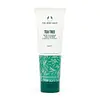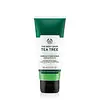What's inside
What's inside
 Key Ingredients
Key Ingredients

 Benefits
Benefits

 Concerns
Concerns

 Ingredients Side-by-side
Ingredients Side-by-side

Water
Skin ConditioningCoco-Glucoside
CleansingCocamidopropyl Betaine
CleansingGlycerin
HumectantDecyl Glucoside
CleansingPropanediol
SolventAlcohol Denat.
AntimicrobialPerlite
AbsorbentSodium Chloride
MaskingPhenoxyethanol
PreservativeAcrylates/C10-30 Alkyl Acrylate Crosspolymer
Emulsion StabilisingChondrus Crispus Powder
AbrasiveCaprylyl Glycol
EmollientMelaleuca Alternifolia Leaf Oil
AntioxidantXanthan Gum
EmulsifyingMannitol
HumectantSodium Gluconate
Skin ConditioningSalicylic Acid
MaskingCellulose
AbsorbentSodium Hydroxide
BufferingMenthol
MaskingLimonene
PerfumingCalophyllum Inophyllum Seed Oil
AntimicrobialTocopheryl Acetate
AntioxidantLeptospermum Petersonii Oil
MaskingHydroxypropyl Methylcellulose
Emulsion StabilisingTocopherol
AntioxidantCI 19140
Cosmetic ColorantCI 42090
Cosmetic ColorantWater, Coco-Glucoside, Cocamidopropyl Betaine, Glycerin, Decyl Glucoside, Propanediol, Alcohol Denat., Perlite, Sodium Chloride, Phenoxyethanol, Acrylates/C10-30 Alkyl Acrylate Crosspolymer, Chondrus Crispus Powder, Caprylyl Glycol, Melaleuca Alternifolia Leaf Oil, Xanthan Gum, Mannitol, Sodium Gluconate, Salicylic Acid, Cellulose, Sodium Hydroxide, Menthol, Limonene, Calophyllum Inophyllum Seed Oil, Tocopheryl Acetate, Leptospermum Petersonii Oil, Hydroxypropyl Methylcellulose, Tocopherol, CI 19140, CI 42090
Water
Skin ConditioningSodium Laureth Sulfate
CleansingGlycerin
HumectantLauryl Betaine
CleansingAcrylates Copolymer
PEG-40 Hydrogenated Castor Oil
EmulsifyingPropanediol
SolventPerlite
AbsorbentPhenoxyethanol
PreservativeMelaleuca Alternifolia Leaf Oil
AntioxidantMannitol
HumectantSodium Chloride
MaskingP-Anisic Acid
MaskingSodium Hydroxide
BufferingCellulose
AbsorbentPEG-120 Methyl Glucose Dioleate
EmulsifyingAcacia Concinna Fruit Extract
Skin ConditioningBalanites Aegyptiaca Fruit Extract
Menthol
MaskingDisodium EDTA
Gypsophila Paniculata Root Extract
Skin ConditioningCalophyllum Inophyllum Seed Oil
AntimicrobialLimonene
PerfumingCitral
PerfumingTocopheryl Acetate
AntioxidantPotassium Sorbate
PreservativeSodium Benzoate
MaskingCitronellol
PerfumingLinalool
PerfumingSorbic Acid
PreservativeHydroxypropyl Methylcellulose
Emulsion StabilisingLeptospermum Petersonii Oil
MaskingCitric Acid
BufferingTocopherol
AntioxidantCI 19140
Cosmetic ColorantCI 42090
Cosmetic ColorantWater, Sodium Laureth Sulfate, Glycerin, Lauryl Betaine, Acrylates Copolymer, PEG-40 Hydrogenated Castor Oil, Propanediol, Perlite, Phenoxyethanol, Melaleuca Alternifolia Leaf Oil, Mannitol, Sodium Chloride, P-Anisic Acid, Sodium Hydroxide, Cellulose, PEG-120 Methyl Glucose Dioleate, Acacia Concinna Fruit Extract, Balanites Aegyptiaca Fruit Extract, Menthol, Disodium EDTA, Gypsophila Paniculata Root Extract, Calophyllum Inophyllum Seed Oil, Limonene, Citral, Tocopheryl Acetate, Potassium Sorbate, Sodium Benzoate, Citronellol, Linalool, Sorbic Acid, Hydroxypropyl Methylcellulose, Leptospermum Petersonii Oil, Citric Acid, Tocopherol, CI 19140, CI 42090
Ingredients Explained
These ingredients are found in both products.
Ingredients higher up in an ingredient list are typically present in a larger amount.
Calophyllum Inophyllum Seed Oil comes from the Tamanu tree. This tree grows in tropical regions of Asia and Polynesian countries such as Fiji.
Calophyllum Inophyllum Seed Oil contains many fatty acids such as linoleic, oleic, stearic, and palmitic acid. These properties help your skin stay hydrated.
As an antioxidant, Calophyllum Inophyllum Seed Oil may also slow down the signs of aging. Antioxidants help fight unstable free-radical molecules. These molecules may damage your skin cells and speed up aging. By helping to stabilize these molecules, antioxidants may help slow the signs of aging.
A study from 2015 found Tamanu oil to have antibacterial and anti-inflammatory properties.
Another study from 2009 found Tamanu Oil to help absorb UV rays. However, this should not replace your sunscreen.
Due to the fatty acid content, this ingredient may not be fungal-acne safe.
Learn more about Calophyllum Inophyllum Seed OilCellulose is the main component of plant cell walls. It is used as an emulsifier, absorbent, and texture enhancer.
This ingredient has many functions:
Fun fact: Cellulose is the most abundant form of organic polymer on Earth.
Learn more about CelluloseCI 19140 is also known as Tartrazine. Tartrazine is a synthetic dye used in cosmetics, foods, and medicine to add a yellow color.
Tartrazine is created from petroleum and is water-soluble.
Some people may experience allergies from this dye, especially asthmatics and those with an aspirin intolerance.
Learn more about CI 19140Ci 42090 is a synthetic dye created from petroleum. It is used to give a bright blue color to cosmetics, medicine, and food.
Glycerin is already naturally found in your skin. It helps moisturize and protect your skin.
A study from 2016 found glycerin to be more effective as a humectant than AHAs and hyaluronic acid.
As a humectant, it helps the skin stay hydrated by pulling moisture to your skin. The low molecular weight of glycerin allows it to pull moisture into the deeper layers of your skin.
Hydrated skin improves your skin barrier; Your skin barrier helps protect against irritants and bacteria.
Glycerin has also been found to have antimicrobial and antiviral properties. Due to these properties, glycerin is often used in wound and burn treatments.
In cosmetics, glycerin is usually derived from plants such as soybean or palm. However, it can also be sourced from animals, such as tallow or animal fat.
This ingredient is organic, colorless, odorless, and non-toxic.
Glycerin is the name for this ingredient in American English. British English uses Glycerol/Glycerine.
Learn more about GlycerinThis ingredient is a semi-synthetic polymer created from cellulose. In case you need a refresher, cellulose is the main component of plant cell walls.
Hydroxypropyl Methylcellulose has many uses:
- emulsifier
- create a gel-like texture
- boost foam
Leptospermum Petersonii Oil is a fragrance and is an oil.
Limonene is a fragrance that adds scent and taste to a formulation.
It's found in the peel oil of citrus fruits and other plants such as lavender and eucalyptus. The scent of limonene is generally described as "sweet citrus".
Limonene acts as an antioxidant, meaning it helps neutralize free radicals.
When exposed to air, oxidized limonene may sensitize the skin. Because of this, limonene is often avoided by people with sensitive skin.
The term 'fragrance' is not regulated in many countries. In many cases, it is up to the brand to define this term. For instance, many brands choose to label themselves as "fragrance-free" because they are not using synthetic fragrances. However, their products may still contain ingredients such as essential oils that are considered a fragrance.
Learn more about LimoneneMannitol is a sugar alcohol. It is a humectant and moisturizes the skin. In vitro (not tested on a living organism), mannitol displays antioxidant properties.
When found in aqueous solutions, mannitol tends to become acidic. This is because it loses a hydrogen ion. This is why mannitol can often be found with pH adjusting ingredients, such as sodium bicarbonate.
Fun fact: Mannitol can be found in foods as a sweetener. It can be naturally found in mushrooms, algae, fruits, and veggies.
Learn more about MannitolThis tea tree oil comes from the leaves of the Tea Tree plant. Tea tree oil has antioxidant, anti-inflammatory, and antimicrobial properties.
According to the book Journal of Profiles of Drug Substances, tea tree helps in reducing acne-causing bacteria such as Propionibacterium acnes. This is due to the Terpinen components of tea tree oil.
Tea tree may cause sensitivity and irritation for some people. This oil naturally contains fragrance such as linalool and limonene.
However, research shows irritation usually occurs when using pure tea tree oil and not in cosmetic products.
Tea tree oil was found to help relieve the symptoms of psoriasis in one study.
Tea tree oil is toxic when ingested. Another study showed it to caused damage to the nervous system of dogs and cats when applied to their skin or given orally.
Learn more about Melaleuca Alternifolia Leaf OilMenthol is a compound found in mint plants, such as peppermint. In its pure form, it is a clear crystalline substance.
Menthol is known for its cooling sensation; however, the cooling is actually from your skin being sensitized. Menthol can worsen rosacea. We recommend speaking with a professional if you have concerns.
Menthol also has antimicrobial properties.
Learn more about MentholWe don't have a description for Perlite yet.
Phenoxyethanol is a preservative that has germicide, antimicrobial, and aromatic properties. Studies show that phenoxyethanol can prevent microbial growth. By itself, it has a scent that is similar to that of a rose.
It's often used in formulations along with Caprylyl Glycol to preserve the shelf life of products.
Propanediol is an all-star ingredient. It softens, hydrates, and smooths the skin.
It’s often used to:
Propanediol is not likely to cause sensitivity and considered safe to use. It is derived from corn or petroleum with a clear color and no scent.
Learn more about PropanediolChances are, you eat sodium chloride every day. Sodium Chloride is also known as table salt.
This ingredient has many purposes in skincare: thickener, emulsifier, and exfoliator.
You'll most likely find this ingredient in cleansers where it is used to create a gel-like texture. As an emulsifier, it also prevents ingredients from separating.
There is much debate on whether this ingredient is comedogenic. The short answer - comedogenic ratings don't tell the whole story. Learn more about comegodenic ratings here.
The concensus about this ingredient causing acne seems to be divided. Research is needed to understand if this ingredient does cause acne.
Scrubs may use salt as the primary exfoliating ingredient.
Learn more about Sodium ChlorideSodium Hydroxide is also known as lye or caustic soda. It is used to adjust the pH of products; many ingredients require a specific pH to be effective.
In small amounts, sodium hydroxide is considered safe to use. However, large amounts may cause chemical burns due to its high alkaline.
Your skin has a natural pH and acid mantle. This acid mantle helps prevent harmful bacteria from breaking through. The acid mantle also helps keep your skin hydrated.
"Alkaline" refers to a high pH level. A low pH level would be considered acidic.
Learn more about Sodium HydroxideTocopherol (also known as Vitamin E) is a common antioxidant used to help protect the skin from free-radicals and strengthen the skin barrier. It's also fat soluble - this means our skin is great at absorbing it.
Vitamin E also helps keep your natural skin lipids healthy. Your lipid skin barrier naturally consists of lipids, ceramides, and fatty acids. Vitamin E offers extra protection for your skin’s lipid barrier, keeping your skin healthy and nourished.
Another benefit is a bit of UV protection. Vitamin E helps reduce the damage caused by UVB rays. (It should not replace your sunscreen). Combining it with Vitamin C can decrease sunburned cells and hyperpigmentation after UV exposure.
You might have noticed Vitamin E + C often paired together. This is because it is great at stabilizing Vitamin C. Using the two together helps increase the effectiveness of both ingredients.
There are often claims that Vitamin E can reduce/prevent scarring, but these claims haven't been confirmed by scientific research.
Learn more about TocopherolTocopheryl Acetate is AKA Vitamin E. It is an antioxidant and protects your skin from free radicals. Free radicals damage the skin by breaking down collagen.
One study found using Tocopheryl Acetate with Vitamin C decreased the number of sunburned cells.
Tocopheryl Acetate is commonly found in both skincare and dietary supplements.
Learn more about Tocopheryl AcetateWater. It's the most common cosmetic ingredient of all. You'll usually see it at the top of ingredient lists, meaning that it makes up the largest part of the product.
So why is it so popular? Water most often acts as a solvent - this means that it helps dissolve other ingredients into the formulation.
You'll also recognize water as that liquid we all need to stay alive. If you see this, drink a glass of water. Stay hydrated!
Learn more about Water